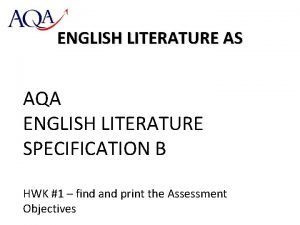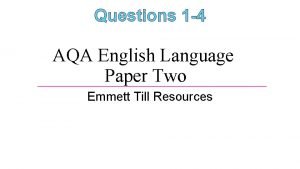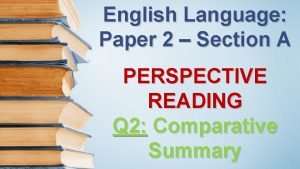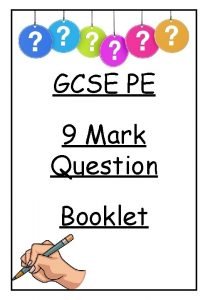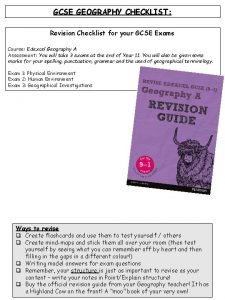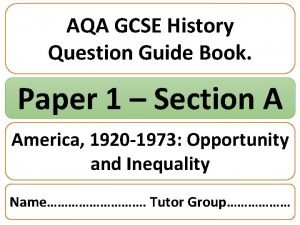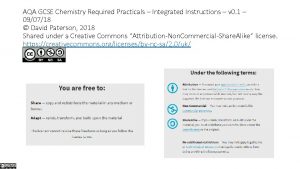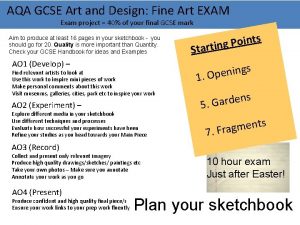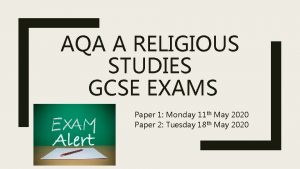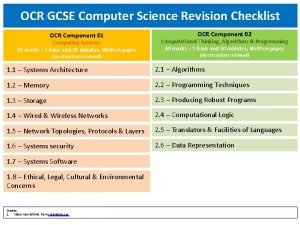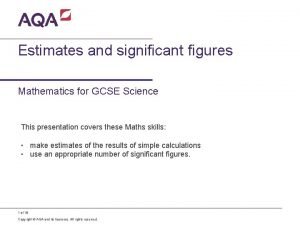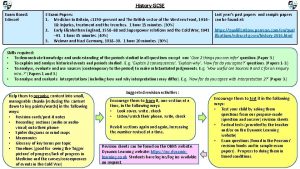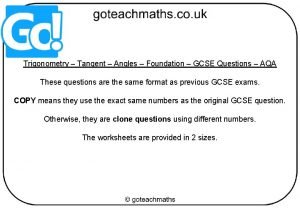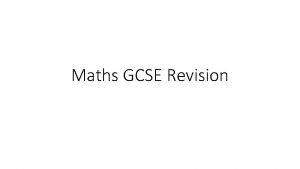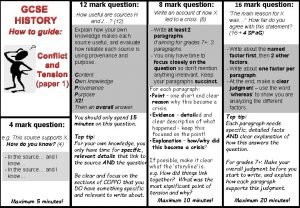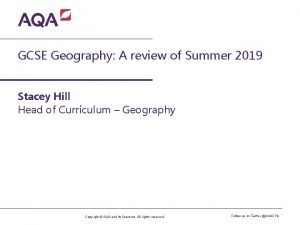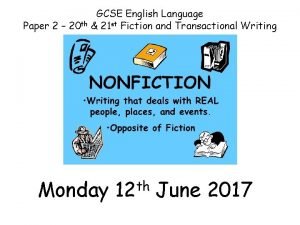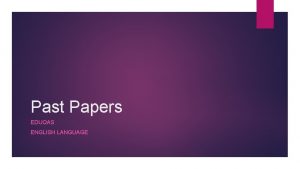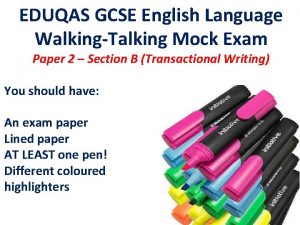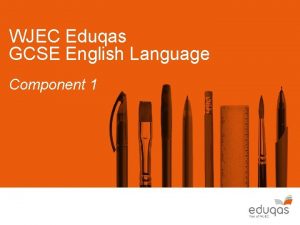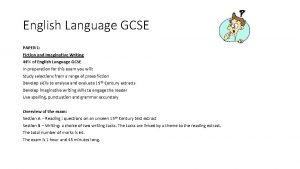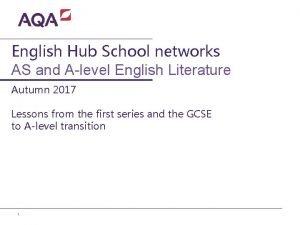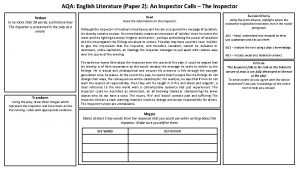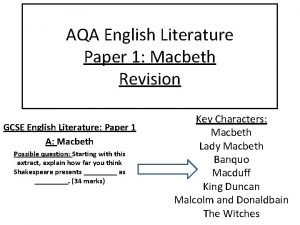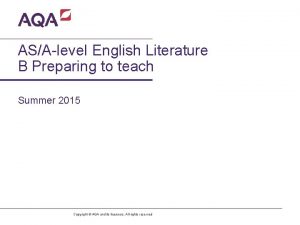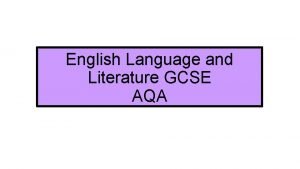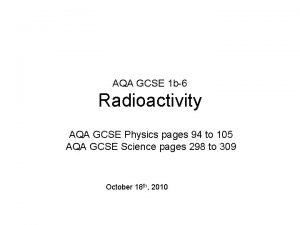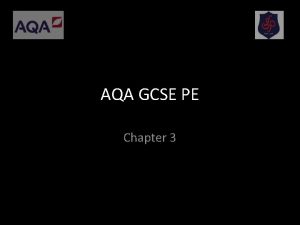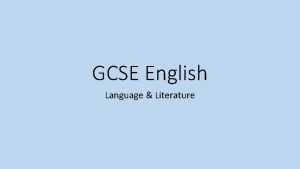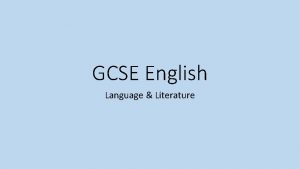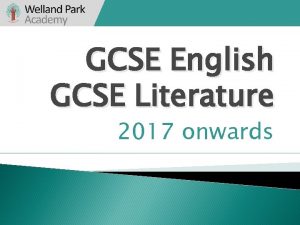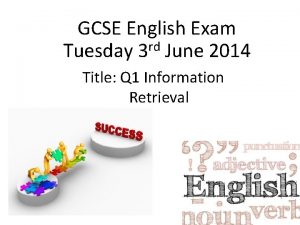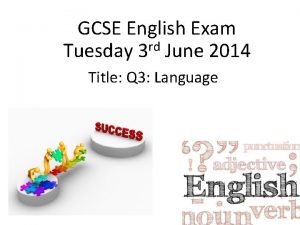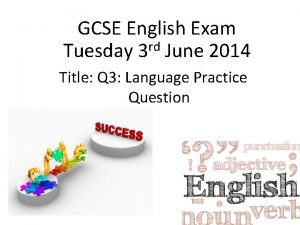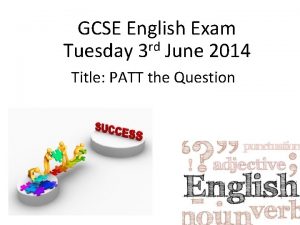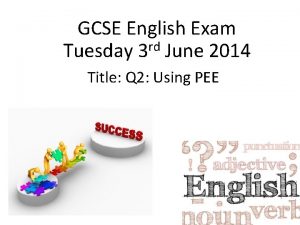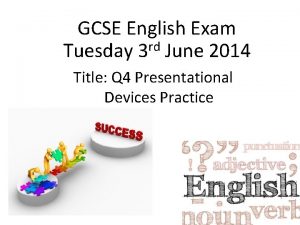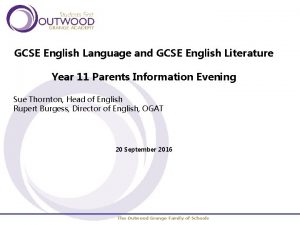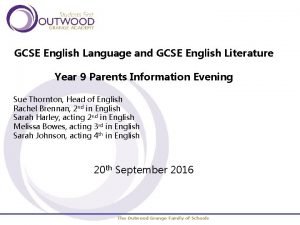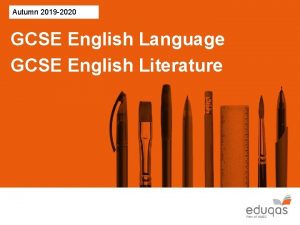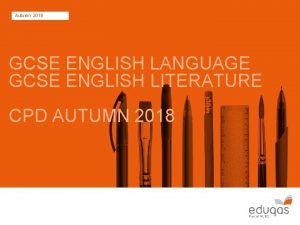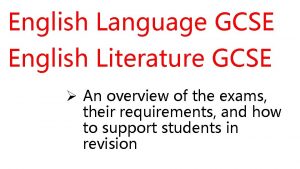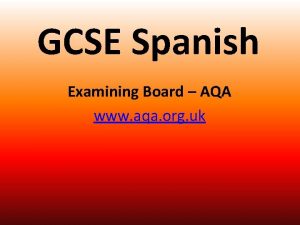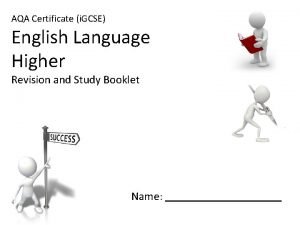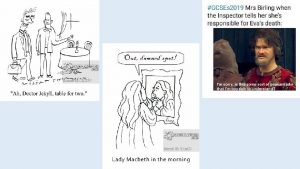Introduction to teaching GCSE English Language Copyright AQA





























- Slides: 29

Introduction to teaching GCSE English Language Copyright © AQA and its licensors. All rights reserved. Follow us on Twitter @AQA.

Focus of the session • Overview of the specification • Introduction to the Assessment Objectives • The assessment journey - structure and symmetry • A walk-through each exam paper question by question • Spoken language endorsement Copyright©©AQA AQAand anditsitslicensors. All Allrightsreserved.

GCSE English Language specification at a glance Paper 1: Explorations in Creative Reading and Writing Paper 2: Writers' Viewpoints and Perspectives What's assessed Section A: Reading • one literature fiction text Section B: Writing • descriptive or narrative writing What's assessed Section A: Reading • one non-fiction text and one literary nonfiction text Section B: Writing • writing to present a viewpoint Assessed • written exam: 1 hour 45 minutes • 80 marks • 50% of GCSE Questions Reading (40 marks) (25%)– one single text • 1 short form question (1 x 4 marks) • 2 longer form questions (2 x 8 marks) • 1 extended question (1 x 20 marks) Writing (40 marks) (25%) • 1 extended writing question (24 marks for content, 16 marks for technical accuracy) Questions Reading (40 marks) (25%) – two linked texts • 1 short form question (1 x 4 marks) • 2 longer form questions (1 x 8, 1 x 12 marks) • 1 extended question (1 x 16 marks) Writing (40 marks) (25%) • 1 extended writing question (24 marks for content, 16 marks for technical accuracy) Copyright©©AQA AQAand anditsitslicensors. All Allrightsreserved.

GCSE English Language specification at a glance Non-examination Assessment: Spoken Language What's assessed (AO 7–AO 9) • presenting • responding to questions and feedback • use of Standard English Assessed • teacher set throughout course • marked by teacher • separate endorsement (0% weighting of GCSE) Copyright © AQA and its licensors. All rights reserved.

Assessment objectives - Reading AO Descriptor AO 1 Identify and interpret explicit and implicit information and ideas. Select and synthesise evidence from different texts. AO 2 Explain, comment on and analyse how writers use language and structure to achieve effects and influence readers, using relevant subject terminology to support their views. AO 3 Compare writers’ ideas and perspectives, as well as how these are conveyed, across two or more texts. AO 4 Evaluate texts critically and support this with appropriate textual references. Copyright © AQA and its licensors. All rights reserved.

Assessment objectives - Writing AO Descriptor AO 5 Communicate clearly, effectively and imaginatively, selecting and adapting tone, style and register for different forms, purposes and audiences. Organise information and ideas, using structural and grammatical features to support coherence and cohesion of texts. AO 6 Use a range of vocabulary and sentence structures for clarity, purpose and effect, with accurate spelling and punctuation. Copyright © AQA and its licensors. All rights reserved.

An accessible enabling qualification • An assessment journey that supports students through each paper • Two clear and distinct identities: Explorations in Creative Reading and Writers’ Viewpoints and Perspectives • Simplicity and symmetry in both papers • Scaffolding to develop progression • Integrated reading and writing tasks on both papers • Assessment of a single AO per question Copyright © AQA and its licensors. All rights reserved.

Copyright © AQA and its licensors. All rights reserved. https: //filestore. aqa. org. uk/resources/english/AQA-GCSE-ENG-PTT-SYMMETRY. PDF

Paper 1 – Explorations in Creative Reading and Writing June 2018 • Source A – 21 st Century prose-fiction* Jigs and Reels by Joanne Harris An extract from a collection of short stories published in 2004 * Source could be 20 th Century prose-fiction depending on source used in Paper 2 Copyright © AQA and its licensors. All rights reserved.

Paper 1 - Question 1 A 01 - Identify explicit information Read again the first part of • Lead-in question the source, lines 1 -4. • Straightforward retrieval task List four things about Mr • Supports “chunking. Fisher from this part of the up” source • Use of line references • Helps manage time (4 marks) • Number of lines referenced varies Copyright © AQA and its licensors. All rights reserved. 10

Paper 1 - Question 2 AO 2 - comment on, explain and analyse (language) Look in detail at this extract, from lines 9 to 15 of the source. How does the writer use language here to convey Mr Fisher’s views on books and stories of the past? • Directs to a key section of the extract • ‘chunking-up’ into manageable sections • Use of line references • Bullet points to scaffold You could include the writer’s choice of: • words and phrases • language features and techniques • sentence forms (8 marks) Copyright © AQA and its licensors. All rights reserved. 11

Paper 1 - Question 3 AO 2 - comment on, explain and analyse (structure) You now need to think about the whole of the source. This text is from the beginning of a short story. How has the writer structured the text to interest you as a reader? You could write about: • what the writer focuses your attention on at the beginning of the source • how and why the writer changes this focus as the source develops • any other structural features that interest you. (8 marks) Copyright © AQA and its licensors. All rights reserved.

Thinking about a ladder of skills progression: Level 3 response The mark scheme asks: ü To see some accurate subject terminology (relating to structure) ü To see relevant exemplification (textual reference) ü To have a clear explanation of the effects of some of the structural features (effect and impact) All of which will lead to a demonstration of: ü A clear understanding of structural features. Copyright © AQA and its licensors. All rights reserved.

Paper 1 - Question 4 AO 4 – critical evaluation Focus this part of your answer on the second part of the source, from line 25 to the end. A student said, ‘This part of the story, where Mr Fisher is marking homework, shows Tibbet’s story is better than Mr Fisher expected, and his reaction is extreme. ’ To what extent do you agree? In your response, you could: • consider your own impressions of what Mr Fisher expected Tibbet’s homework to be like • evaluate how the writer conveys Mr Fisher’s reaction to what he discovers • support your response with references to the text. (20 marks) Copyright © AQA and its licensors. All rights reserved.

Being critical and evaluative The question itself is a culmination of the ‘footprint’ of skills: AO 1 > AO 2 > AO 4 The key for students is to: • Have a sense of their own response. However, having constructed a response based on a moral argument or opinion, it must be rooted with references to the text. • Develop the ability to ask questions independently about texts to enable them to interrogate, contest and have a response to what they read. • Use the statement in the question to help inform their interpretation and evaluation of it. Copyright © AQA and its licensors. All rights reserved.

Paper 1 – Question 4 mark scheme See the skills descriptors and the indicative standard for progressive levels of response. How the indicative standard is designed to function: • not as model answers • not as exhaustive or complete responses • but as an indication of the type of level of response. Copyright © AQA and its licensors. All rights reserved.

Paper 1 – Question 5: AO 5 (content and organisation) and AO 6 (technical accuracy) • Always a choice of written prompt and visual image that is linked to the topic of the reading text in Section A. • Always a creative task focusing on narrative and, or descriptive writing skills: one narration and one description, or two narration. • Marks for content and organisation (AO 5) as well as for technical accuracy (AO 6). • Mark scheme designed to encourage ambition. • Section B will be allocated 40 marks to give an equal weighting to the reading and writing tasks. Copyright © AQA and its licensors. All rights reserved.

Examiner feedback ‘What worked well’ The national data for Question 3 showed a marked improvement in performance than in June 2017. ‘Even better if’ The national data shows a balanced performance across most questions, however there are still opportunities for most students to improve further on Question 5. Copyright © AQA and its licensors. All rights reserved.

Paper 2 – Writers’ viewpoints and perspectives June 2018 • Source A: 20 th Century literary non-fiction* Morning Glass An extract from Mike Doyle’s autobiography, published in 1993. • Source B: 19 th Century non-fiction The Hawaiian Archipelago An extract from a letter written by Isabella Bird, published in 1875. * Source could be 21 st Century non-fiction depending on source used in Paper 1 Copyright © AQA and its licensors. All rights reserved.

Paper 2 - Question 1 A 01 Identify and interpret explicit and implicit information and ideas Read again the first part of Source A from lines 1 to 13. Choose four statements below which are TRUE. • Shade the boxes of the ones that you think are true • Choose a maximum of four statements Lead-in question True/false statements Thinking scaffold A response to reading without writing • Supports “chunking-up” • Use of line references • Help manage time • • (8 statements given with boxes to shade) (4 marks) Copyright © AQA and its licensors. All rights reserved. 20

Paper 2 - Question 2 A 01 Select and synthesise evidence from different texts You need to refer to Source A and Source B for this question. Both sources describe the types of board used for surfing. Use details from both sources to write a summary of what you understand about the different boards used by the surfers. (8 marks) Copyright © AQA and its licensors. All rights reserved.

Paper 2 – Question 2: Stepping stone to Q 4 Paper 2 Q 2 tests AO 1 skills using two texts. To be successful at the top level of the mark scheme, students need to: • Make perceptive inferences from both texts • Make judicious references/use of textual detail – relevant to the focus of the question • Show perceptive differences between texts. A ‘stepping stone’ to Paper 2 Q 4 which tests AO 3 comparison. Students need to additionally: • compare how ideas are conveyed • analyse the methods used. Copyright © AQA and its licensors. All rights reserved.

The mark scheme: Level 3 response • Makes clear inferences from both texts • Selects clear references /textual detail relevant to the focus of the question • Statements show clear differences between texts. This leads to: ü Showing a clear understanding of the differences. Copyright © AQA and its licensors. All rights reserved.

Paper 2 - Question 3 AO 2 - comment on, explain and analyse (language) You now need to refer only to Source B from lines 18 to 25. How does the writer use language to describe the surfers and the sea? • Self-select language features from one source • The exam paper will state either Source A or B • This can change each year (12 marks) Copyright © AQA and its licensors. All rights reserved. 24

Paper 2 - Question 4 AO 3 – comparison of writers’ ideas/perspectives and methods For this question, you need to refer to the whole of Source A, together with the whole of Source B. Compare how the writers convey their different perspectives on surfing. In your answer, you could: • compare their different perspectives on surfing • compare the methods the writers use to convey their perspectives • support your response with references to both texts. (16 marks) Copyright © AQA and its licensors. All rights reserved.

Paper 2 – Question 5 AO 5 (content and organisation) and AO 6 (technical accuracy) ‘All sport should be fun, fair and open to everyone. These days, sport seems to • be more about money, corruption and winning at any cost. ’ • Write an article for a newspaper in which you explain your point of view on this statement. Topic / theme linked to reading material Clear sense of form, audience and purpose (24 + 16 marks) Copyright © AQA and its licensors. All rights reserved. 26

Examiner feedback ‘What worked well’ Question 3 seemed to be one of the more successful questions for students. ‘Even better if’ Question 4 is one of the questions where, nationally, there was a trend for it to be less successful for students. Copyright © AQA and its licensors. All rights reserved. 27

Spoken Language Assessment Objectives AO 7 • Demonstrate presentation skills in a formal setting AO 8 • Listen and respond appropriately to spoken language, including to questions and feedback on presentations AO 9 • Use spoken Standard English effectively in speeches and presentations Copyright © AQA and its licensors. All rights reserved.

Resources to support the spoken language assessment • A separate endorsement for the GCSE English Language • Compulsory assessment of AO 7 -AO 9 • Formal individual presentation • Inter-board guidance • 12 inter-awarding body produced standardising videos and commentaries (e. AQA) – Charlotte For all other resources: https: //www. aqa. org. uk/resources/english/gcse/englishlanguage-8700/assess/non-exam-assessment-guidespoken-language-endorsement Copyright © AQA and its licensors. All rights reserved.
 Aqa english specification
Aqa english specification Aqa english language paper 1
Aqa english language paper 1 Aqa english language paper 2 rail disasters mark scheme
Aqa english language paper 2 rail disasters mark scheme Sqi english structure
Sqi english structure Aqa gcse pe 9 mark questions
Aqa gcse pe 9 mark questions Edexcel geography gcse checklist
Edexcel geography gcse checklist Gcse history paper 1
Gcse history paper 1 Gcse chemistry required practicals
Gcse chemistry required practicals Aqa gcse art and design
Aqa gcse art and design Aqa rs 2020 paper
Aqa rs 2020 paper Aqa gcse maths revision checklist
Aqa gcse maths revision checklist Significant figures gcse
Significant figures gcse History edexcel gcse past papers
History edexcel gcse past papers Trigonometry questions gcse aqa
Trigonometry questions gcse aqa Aqa maths gcse revision guide
Aqa maths gcse revision guide How useful questions gcse history
How useful questions gcse history Aqa gcse geography
Aqa gcse geography Edexcel gcse english language
Edexcel gcse english language Aqa eng lang paper 2
Aqa eng lang paper 2 What is in english literature paper 1 edexcel
What is in english literature paper 1 edexcel Lucy faulkner english language
Lucy faulkner english language Eduqas gcse english language past papers
Eduqas gcse english language past papers Eduqas gcse english language
Eduqas gcse english language The lovely bones language paper 1 answers
The lovely bones language paper 1 answers English fiction and imaginative writing
English fiction and imaginative writing Nea prohibited texts
Nea prohibited texts Is inspector calls paper 1 or 2
Is inspector calls paper 1 or 2 Macbeth revision
Macbeth revision Aqa a level english literature b poetry anthology
Aqa a level english literature b poetry anthology Aqa english literature paper 1 2019 a christmas carol
Aqa english literature paper 1 2019 a christmas carol
